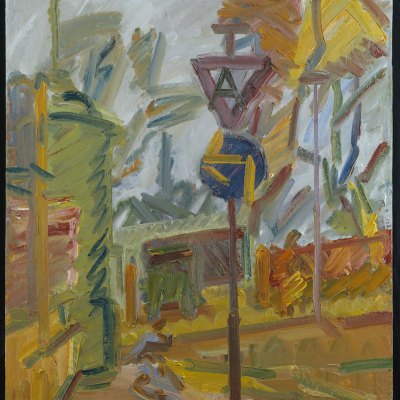I have had some fairly interesting experiences at private views. I’ve seen sculptures smashed, fights break out and a lot of really unlikely schmoozing going on. I even spotted Sean Penn outside a Sprüth Magers opening once. He is a lot shorter in person than you’d expect. As memorable PV related recollections go, though, what happened to me last Thursday beats all comers as far as I’m concerned.
I was walking down the Charing Cross Road from Soho, intent on investigating ‘All the Revolving Cells’, the new group show at the Tenderpixel gallery (until 28 November). Tenderpixel puts on some interesting shows by a good range of international artists you are unlikely to have heard of. It can be hit and miss, but I admire the variety of styles and the aesthetic, which is decidedly rough around the edges. If you want to see something new and intriguing, you could do worse than to sign up for their mailing list.
More interesting still is the locale. Cecil Court is a little pedestrian street that runs between Charing Cross Road and Covent Garden, which for reasons I’ve never fully understood has long been a centre for London’s antiquarian book trade. In recent years, its olde worlde cred was cemented by its role as a location in the Harry Potter films. In any case, it’s a weird address for a cutting edge contemporary art gallery.
I’d almost made it to the turn-off from the main road when an object landed directly in front of me and erupted in a cloud of purple smoke. Without pausing to think, I legged it and almost collided with a group of very merry pranksters in Guy Fawkes masks. Too late, I realised I really should’ve taken a different route: I was now in the midst of the annual ‘million mask march’ organised by supporters of ‘hacktivist’ anti-capitalist group Anonymous.
Protest is good (though that Guy mask really is one of history’s most irritating designs), but not when you’re accidentally stuck in one facing an imminent kettling. Through a fug of coloured smoke, I discerned a line of cops in fluorescent jackets running to the end of Cecil Court, and the sense of impending doom that normally signals a panic attack began to take hold. I made the least dignified run that I possibly could in the general direction I wanted to go, and made it through in the nick of time, wailing ‘please!’ at demonstrators and policemen alike. Minutes later, cordons had blocked off the surrounding streets.
Needless to say, I didn’t take in much of the show.
◎
Less dramatic, perhaps, but rather more instructive is Beetles + Huxley’s Berenice Abbott show (until 21 November). Originally from Ohio, Abbott trained as a sculptor in Paris, but failed to make ends meet and wound up as Man Ray’s assistant. The experience led her to photography, back to the USA, and ultimately to some of the most remarkable images of the 20th century. The show begins with portraits of James Joyce and Abbott’s hero Eugène Atget (the latter taken shortly before the subject’s death) and ends with a series of beautiful scientific photographs.
Along the way, we see some profoundly alienating pictures of the great construction projects of 1930s New York, petrol pumps, bridges and washing lines occupying the focal points where you would expect a figure. As in Atget’s ghostly photographs, people are largely absent from these images. She captured the same ghostly modernity in her homeland as he had in his four decades before. Even an unglamorous automat selling pies and sandwiches for ¢57 is rendered as forbidding and inhuman as a machine gun.
It’s made me want to buy a camera, but past experiences with photography and a habit of losing any electronic device I come into contact with suggests I should exercise caution with this particular impulse. Go and see the show while it’s still on – you might just feel the same way.
◎
Finally, I dropped into the new Sadie Coles HQ on Davies Street for the opening of its Rudolf Stingel exhibition (until 18 December). While I wouldn’t suggest running over there to see Stingel’s new work, the gallery itself is pretty impressive in its high modernist way. As for the opening? Nothing was smashed, no anarchist uprising erupted and Sean Penn was nowhere to be seen. This, probably, is all for the best.



